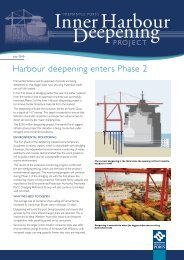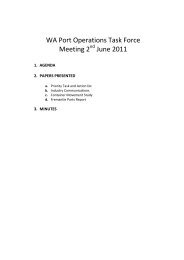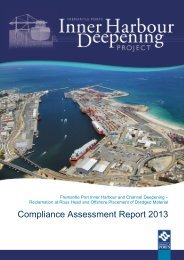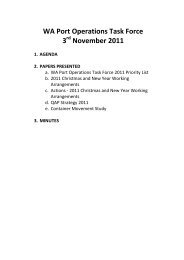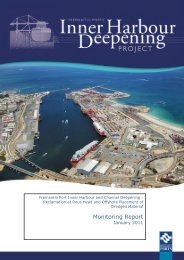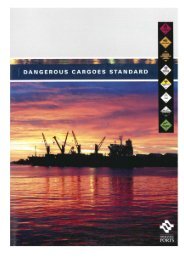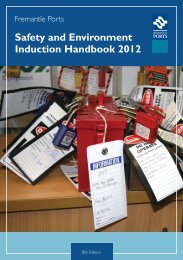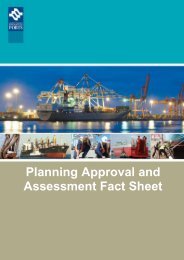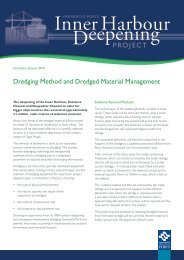Fremantle Port Inner Harbour and Channel ... - Fremantle Ports
Fremantle Port Inner Harbour and Channel ... - Fremantle Ports
Fremantle Port Inner Harbour and Channel ... - Fremantle Ports
- No tags were found...
You also want an ePaper? Increase the reach of your titles
YUMPU automatically turns print PDFs into web optimized ePapers that Google loves.
4. DiscussionWithin the Offshore Disposal Area, <strong>and</strong> surrounding zones of potential loss <strong>and</strong> effect fromthe IHD Project, 19.9 ha of seagrass loss was conservatively estimated to occur between pre<strong>and</strong>post-disposal habitat surveys. The majority of seagrass loss (76%) was within thebounds of the Offshore Disposal Area resulting from burial by disposed sediments. Seagrassloss in the surrounding area was likely due to plumes at the time of disposal <strong>and</strong>/or sedimentresuspension <strong>and</strong> redistribution of dredged materials causing indirect smothering <strong>and</strong>/or lightlimitation of seagrass.The selection of 15 permanent seagrass recovery monitoring sites within 'undisturbed','transitional' <strong>and</strong> 'disturbed' zones was validated with statistically significant differencesbetween zones in seagrass percentage cover <strong>and</strong> shoot density. Percentage cover ofP angustifolia ranged from 4-22% cover at disturbed sites, 17-27% at transition sites <strong>and</strong> 34-67% at undisturbed sites. The seabed was dominated by s<strong>and</strong> (30-87% cover) at disturbed<strong>and</strong> transition sites, while P. angustifolia dominated the coverage of the seabed atundisturbed sites. Wrack was also prominent at the transition site 11T <strong>and</strong> undisturbed site10H, <strong>and</strong> may be partially controlling the percentage cover of seagrass at these sites. Datafor undisturbed sites showed that mean shoot density (257-407 shoots per m 2 ) was withinthe range of natural seasonal variation recorded from the three sites monitored prior thissurvey (284-732 shoots per m 2 (Oceanica 2010a)). Seagrass density ranged from 12-407shoots per m 2 overall, which was within recorded variability for sites at this depth in thisarea. Seagrass density at disturbed sites ranged from 12-240 shoots per m 2 , at transitionsites ranged from 100-293 shoots per m 2 <strong>and</strong> undisturbed sites ranged from 257-407 shootsper m 2 . These statistically different values for both seagrass percentage cover <strong>and</strong> shootdensities represent a strong baseline data set to record potential future seagrass recoverywithin zones at these sites.Multivariate analysis of whole sediment nutrients <strong>and</strong> metals showed no combination ofchemical analytes was controlling the percentage cover or density of P. angustifolia.Sediment physicochemical data demonstrated no relevant differences in PSD, nutrients ormetals amongst zones which were considered to be able to affect seagrass health.Most (12 out of 15) permanent seagrass monitoring sites were not within bathymetry surveyarea. This was primarily due an expected lack of suitable seagrass sites within the OffshoreDisposal Area <strong>and</strong> the limited bathymetric survey area beyond the boundary of the OffshoreDisposal Area. Bathymetry data at the permanent seagrass monitoring sites which werewithin the survey area showed some sediment accumulation (0-0.02 m) during the pre- topost-disposal time frame (December 2010 to December 2011), but this level of accuracy iswithin the error of the bathymetric data <strong>and</strong> is not considered reliable. Although theavailable data does not allow for a quantitative analysis, it does highlight the possibility thatredistribution of sediments at disposal areas has the potential to affect seagrass recovery.Oceanica: <strong>Fremantle</strong> <strong>Port</strong>s: FP – Gage Roads Offshore Disposal Area Seagrass Recovery Project, Phase I – Initial Survey 33



